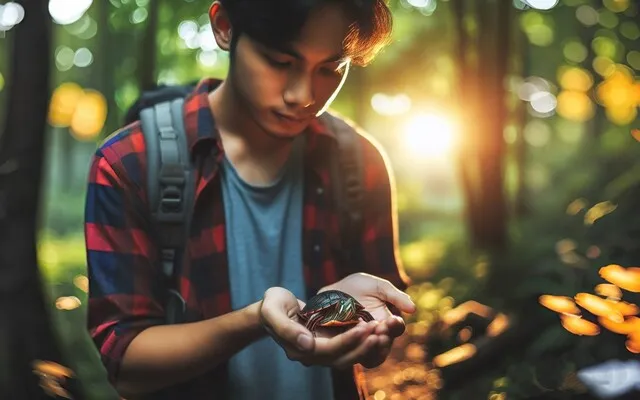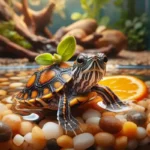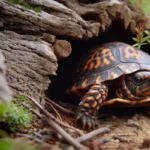Welcome to PetTurtleTips, where we cover all things related to the enchanting world of pets. In today’s post, our primary focus is on the striking painted turtles as pets.
These visually appealing reptiles are not only a treat for the eyes but also make excellent pets for those in search of low-maintenance, yet interactive companions.
Throughout this blog post, we will be offering crucial care tips, recommendations, and insights to assist you in building a thriving and cheerful habitat for your beloved painted turtle.
Understanding Painted Turtles
Species Overview
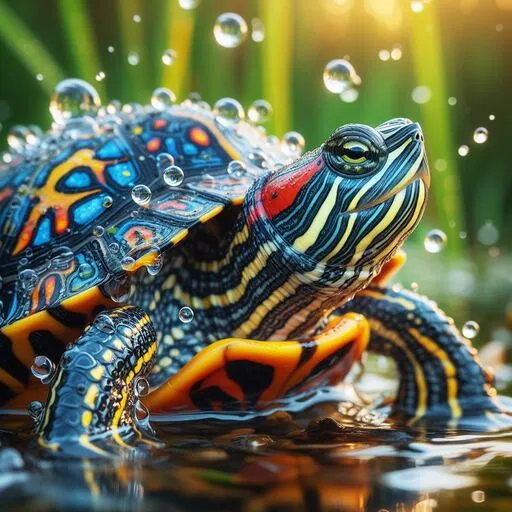
Physical Appearance
Painted turtles are small, colorful reptiles with dark green to black shells adorned with bright red, orange, and yellow markings.
Their plastron (the underside of the shell) is typically yellow with intricate patterns, and their skin is dark with yellow and red stripes.
There are four subspecies of painted turtles, each displaying slightly different colors and patterns.
Lifespan
With proper care, painted turtles can live 25–30 years or even longer in captivity.
This long lifespan signifies that owning a painted turtle is a substantial commitment, and potential owners should be prepared for this responsibility.
Size
Adult painted turtles usually measure between 4-10 inches in length, with females generally larger than males. The size of the painted turtle depends on its subspecies, diet, and living conditions.
Natural Habitat and Behavior
Habitat
Native to North America, painted turtles inhabit various aquatic ecosystems such as ponds, lakes, marshes, and sluggish rivers.
They are particularly drawn to regions with plentiful and thick underwater plant life, which serves as both a refuge and a food source.

Diet
In the wild, painted turtles are omnivores, consuming a variety of insects, crustaceans, fish, and aquatic plants.
A balanced diet for a captive painted turtle should include commercial turtle pellets, mixed with fresh vegetables, leafy greens, and the occasional protein source such as insects, earthworms, or small fish.
Social Behavior
Generally, painted turtles exhibit a non-aggressive nature and can coexist with other turtles of comparable size and temperament.
However, they are not sociable creatures and do not require companionship.
To avoid rivalry and tension in a communal environment, it is essential to provide adequate space and shelter for each turtle.
Creating the Perfect Painted Turtle Habitat
Painted turtles are popular pet reptiles, known for their beautiful colors and gentle nature.
To ensure your painted turtle thrives, provide a suitable habitat that mimics their natural environment.
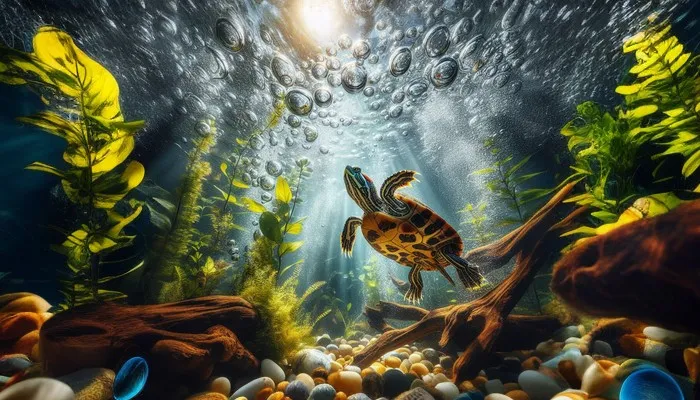
In this section, we will focus on the essential aspects of creating a painted turtle habitat, including aquarium size and setup, heating and lighting, and substrate and decorations.
Aquarium Size and Setup
- Tank Size: Selecting the correct tank size is crucial. A general guideline is to provide 10 gallons of water per inch of shell length. For instance, a 5-inch turtle requires a 50-gallon tank, allowing ample room to swim and explore.
- Water Depth: Painted turtles need a water depth of at least 1.5 times their shell length for free movement. Include a gentle slope or ramp for easy basking area access.
- Basking Area: A dry basking area for warmth and UV light is essential. Use a floating dock, large rock, or commercial turtle basking platform. Ensure the area is large enough for comfortable resting and drying.
Heating and Lighting
- Water Heater: Consistent water temperature (75°F to 80°F) is vital for your turtle’s health. Use a submersible aquarium heater and a reliable thermometer to maintain the temperature.
- Basking Light: A basking light provides warmth, with the basking area’s temperature between 85°F and 90°F. Use a heat lamp or ceramic heat emitter and adjust the distance to prevent overheating.
- UVB Light: Painted turtles require UVB light for vitamin D3 synthesis, essential for calcium absorption and shell development. Place a UVB-emitting bulb over the basking area and replace every 6-12 months.
Substrate and Decorations
- Substrate Options: Substrate forms the tank’s bottom. Suitable options include large river rocks, sand, or a bare bottom tank. Avoid small gravel, as turtles may ingest it, causing impactions.
- Plants and Hiding Places: Add live or artificial aquatic plants for aesthetics, hiding places, and security. Choose turtle-safe plants like Anacharis, Java fern, or hyacinth.
- Safe Decorations: Enhance the environment with driftwood, rocks, and caves. Ensure decorations are free from sharp edges and large enough to prevent swallowing. Arrange them to create a natural and stimulating environment for exploration.
Feeding Your Painted Turtle
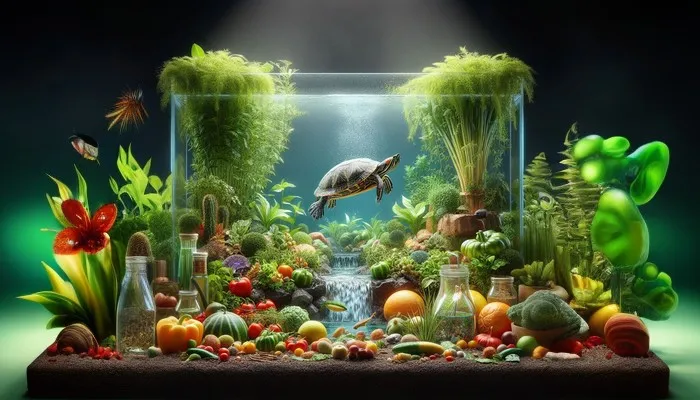
Nutritional Requirements
Protein Source
Painted turtles are omnivorous, requiring a diet that includes both plant-based foods and animal-based proteins.
Their diet should include small fish, insects, and turtle pellets. Offer a variety of protein sources like mealworms, crickets, and earthworms for a balanced diet.
Vegetables and Fruits
Besides protein, painted turtles need vegetables and fruits. Provide dark, leafy greens such as kale, collard greens, and dandelion leaves.
Carrots, squash, and bell peppers are also suitable. Fruits like strawberries, blueberries, and raspberries should be given in moderation, cut into small pieces.
Vitamins and Minerals
A diet rich in essential vitamins and minerals is crucial for painted turtles. Calcium and vitamin D3 help maintain strong bones.
Commercial turtle pellets are fortified with these nutrients, but you can also add calcium supplements like cuttlebones or calcium blocks.
Meal Schedule
Frequency
The frequency at which a turtle is fed depends on its age and size. Feed babies and juveniles daily, while adult turtles can be fed every other day.
Monitor your turtle’s growth and adjust feeding frequency to prevent obesity and health problems.
Portion Size
Offer food about the size of your turtle’s head, including a mix of protein sources, vegetables, and fruits. Adjust portion sizes as your turtle grows to ensure adequate nutrition.
Adjusting for Age and Size
Dietary needs change as painted turtles mature. Juveniles need more protein, while adults require more plant-based foods. As turtles age, decrease protein intake and increase vegetables and fruits.
Treats and Supplements
Treat Options
Give your painted turtle occasional treats like freeze-dried shrimp, bloodworms, or small cooked chicken or fish pieces. Offer treats in small quantities to avoid overeating and health issues.
Calcium Supplement
Calcium is vital for shell and bone health. In addition to fortified pellets, provide calcium supplements like cuttlebones or calcium blocks for your turtle to nibble on.
Avoid Overfeeding
Overfeeding can cause obesity, shell deformities, and other health problems. Ensure appropriate portion sizes, meal frequency, and a balanced diet.
Monitor your turtle’s growth and adjust its diet to maintain optimal health.
Maintaining a Clean and Healthy Environment
Water Quality and Filtration
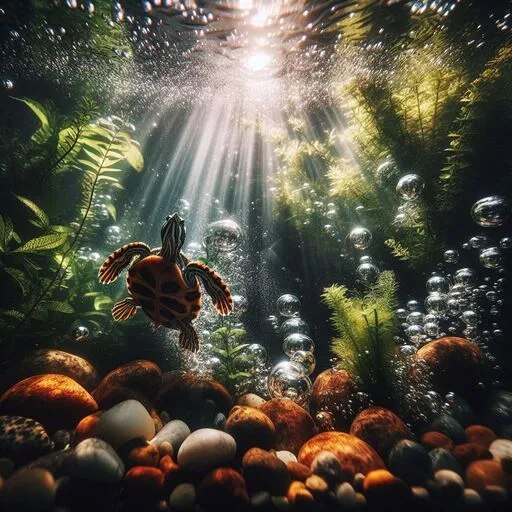
Importance of Water Quality
Good water quality is essential for your painted turtle’s health.
Poor water conditions can cause health problems like skin infections, shell rot, and respiratory issues.
Regularly check the water’s pH, ammonia, nitrite, and nitrate levels, maintaining a pH between 6.5 and 7.5 and minimal ammonia and nitrite levels.
Filter Selection
Choosing the right filter is crucial for proper water quality. Canister filters are suitable for painted turtles, offering both mechanical and biological filtration.
Pick a filter designed for a larger tank size than yours, as turtles produce more waste than fish.
Water Change Routine
Weekly water changes (around 25%) are vital for a healthy turtle environment.
Use a siphon to remove debris and waste, and treat new water with a water conditioner to eliminate harmful chemicals like chlorine before adding it to the tank.
Cleaning the Tank and Accessories
Routine Cleaning
Besides weekly water changes, perform daily cleaning tasks like removing uneaten food and waste using a net or siphon and wiping the tank’s walls and basking area to prevent algae buildup.
Deep Cleaning
Every few months, deep clean your turtle’s tank by removing the turtle and accessories, draining the water, and cleaning all surfaces with a turtle-safe cleaning solution.
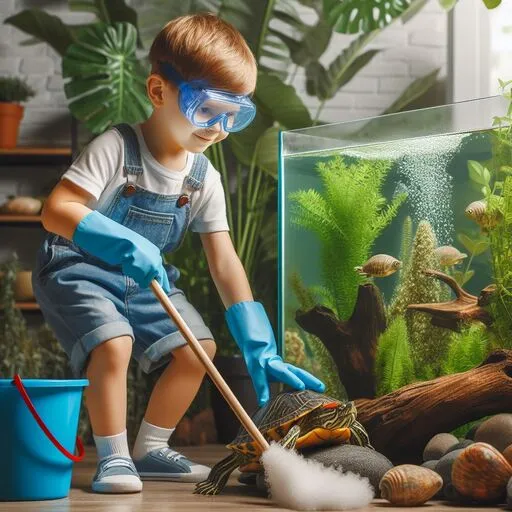
Rinse thoroughly to remove cleaning product residues before refilling the tank and reintroducing your turtle.
Safe Cleaning Products
Use pet-safe cleaning products for your turtle’s tank and accessories.
Avoid harsh chemicals like bleach or ammonia and opt for diluted vinegar or a commercial reptile-safe cleaning solution.
Monitoring Your Turtle’s Health
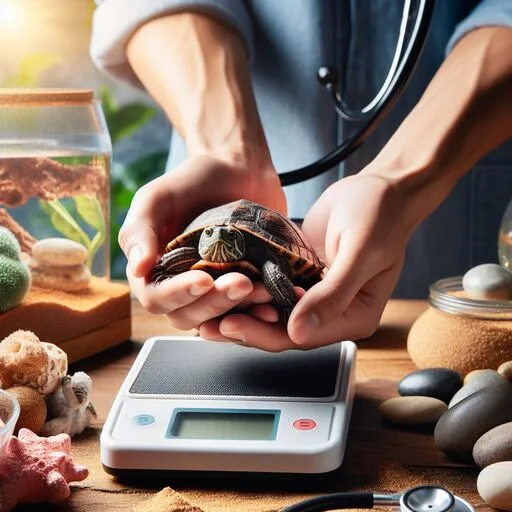
Disease Symptoms
Regularly inspect your painted turtle for signs of illness, such as lethargy, appetite loss, breathing difficulties, swollen eyes, or shell changes.
Consult your veterinarian if you notice any of these symptoms.
Common Health Issues
Painted turtles can experience health issues like respiratory infections, shell rot, and vitamin deficiencies.
Prevent these problems by maintaining a clean habitat, providing a balanced diet, and ensuring proper water conditions.
Consulting a Veterinarian
If you suspect your painted turtle is unwell or notice unusual behavior or symptoms, consult a reptile-experienced veterinarian.
Timely intervention is crucial for addressing health issues and preventing severe complications.
Socializing and Handling Your Painted Turtle
Painted turtles are popular pets due to their hardy nature and low-maintenance care.
Like any pet, understanding proper socializing, handling, and introducing your painted turtle to other pets is crucial.
In this section, we will discusses trust-building, safe handling, and creating a peaceful environment for your painted turtle and other pets.
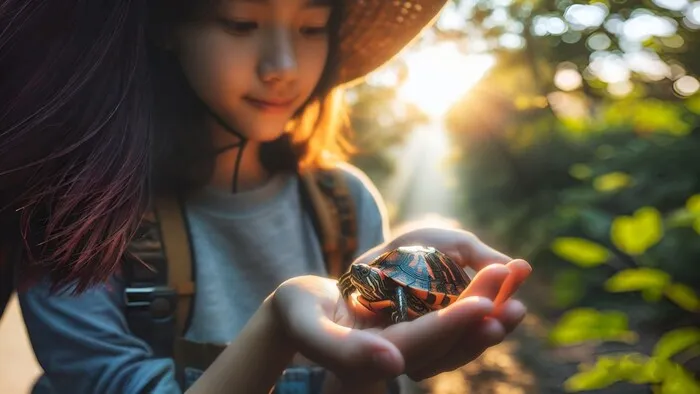
Building Trust with Your Painted Turtle
Gradual Interaction: Patience is vital when building trust with your painted turtle.
Begin by observing from a distance and slowly move closer over time, helping your turtle feel comfortable and less threatened.
Rewarding Positive Behavior: Small food rewards, like fruit or mealworms, can encourage positive interactions.
Reward your turtle when it approaches you or allows touch without stress signs.
Understanding Your Turtle’s Body Language: Observing your turtle’s body language can indicate its comfort level.
A relaxed turtle may swim towards you or bask with extended head and limbs. In contrast, a stressed turtle may retreat, hiss, or bite.
Adjust interactions based on your turtle’s body language.
Safe Handling Techniques for Painted Turtles
Picking Up Your Turtle: Approach your painted turtle from the side, gently grasping it on either side of its shell, just behind the front legs. Avoid grabbing its tail or limbs to prevent injury.
Holding and Supporting: Securely hold your turtle with both hands, supporting its entire body. Keep fingers away from its head to avoid bites.
Minimizing Stress: Limit handling, as painted turtles don’t enjoy being held. Frequent handling can cause stress and health issues.
Handle your turtle only when necessary, like during tank cleanings or health checks.
Introducing Your Painted Turtle to Other Pets
Compatibility with Other Turtles: Painted turtles can coexist with similar-sized, temperament turtles if the enclosure is large enough.
Monitor their interactions closely to prevent aggression or territorial disputes.
Interactions with Other Pets: Avoid introducing your painted turtle to other pets like dogs or cats. Turtles can carry salmonella, harmful to other animals and humans.
Other pets may also view your turtle as prey, risking its safety.
Ensuring a Peaceful Coexistence: Maintain separate living spaces for your painted turtle and other pets, avoiding direct contact.
Regularly clean your turtle’s enclosure to minimize salmonella transmission risk, and wash your hands after handling your turtle or its belongings.
Conclusion
Taking care of a painted turtle is a gratifying and fun experience that offers a fascinating look into the life of these stunning reptiles.
You can establish a caring atmosphere for your painted turtle to flourish by paying attention to the pointers and suggestions offered in this article.
These fascinating creatures are fantastic pets that add delight and amazement to your household with the right care, consideration, and patience.
